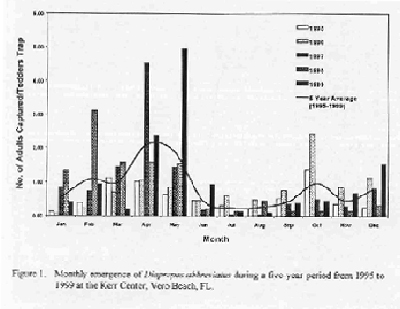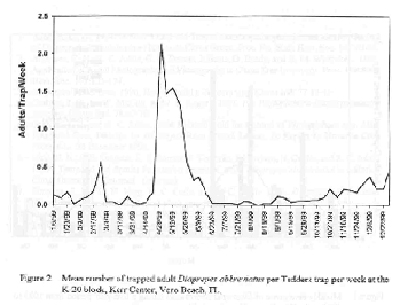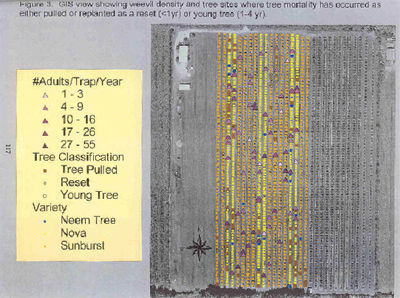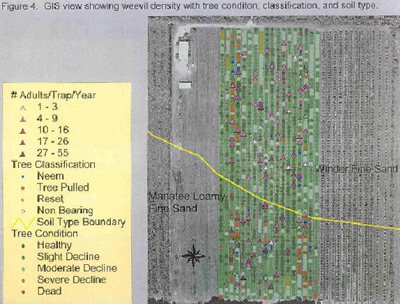Seasonal Abundance and Spatial Distribution of Diaprepes abbreviatus in an East Coast Citrus Grove
Robert C. Adair, Jr.
Kerr Center for Sustainable Agriculture, Inc.
7055 33rd Street
Vero Beach Research Station (VBRS)
Vero Beach, FL 32966
Introduction
Diaprepes abbreviatus is inflicting losses to the Florida citrus industry that exceed $70 million annually (Diaprepes Task Force). Diaprepes is an insidious pest of citrus because tree symptoms do not appear until the larvae are well established on the tree roots. Larval feeding on citrus roots damages the root system and provides an avenue for pathogens such as Phytophthora spp. The pest and pathogen form a complex that, if not treated in a timely fashion, can destroy citrus trees. Growers are now faced with costly treatments for both insect and fungal pathogen. Further concerns are that repetitive applications of systemic fungicides such as Ridomil will develop resistance in Phytophthora spp. (Graham et al., 1997). Currently, there is no method for early detection for Diaprepes. Nothing is known about the point of origin, rate, or direction of spread of an infestation. In addition, it is not known what effects various factors such as prevailing winds, non-citrus landscapes, or physical barriers such as canals, dikes, and highways have on the movement of Diaprepes. Growers with groves near infested sites have no way of knowing when Diaprepes will infest their groves until after the fact. No work has been done that would enable growers to predict when the infestation would reach their groves. Field inspections and trapping to determine the presence of weevils are inefficient and expensive (Nigg et al., 1997). No effort to date has been made to examine aerial photography as a means to either detect or study the movement dynamics of this insect pest. Early detection is a major component currently lacking in the IPM program for Diaprepes and would offer growers the advantage of preventive or at least early treatments. The results presented here show five years of adult emergence data that demonstrate the seasonal abundance of Diaprepes in an East Coast citrus grove. Also presented are spatial distribution patterns, which, along with the abundance data reveal the preliminary steps taken towards developing an early detection strategy for Diaprepes.
Site Description
The study site is located at the Kerr Center groves, west of Vero Beach in Indian River County. The soil types are Winder fine sand and Manatee loamy fine sand. Drainage is accomplished by furrows between raised double beds running 1,200 feet to drainage ditches located at each end of the grove. The 30 acre site is composed of two blocks named the K-10 and the K-20 block. The K-10 block comprises 10 acres and was planted in 1987 with 'Ruby Red' grapefruit trees on 'Swingle' citrumelo rootstock using 12.5 x 25 ft spacing. The K-20 block is 15 acres and was planted in December, 1989 with 'Sunburst' tangerine on 'Swingle' citrumelo rootstock with 15 x 25 ft spacing and 'Nova' tangelo on 'Cleopatra' mandarin as pollinators with 12.5 x 25 ft spacing. During periods of low rainfall, the grove is irrigated with a well maintained micro irrigation system. Diaprepes was first detected at this site in May, 1990 and has been infested since then. Conventional caretaking practices for fresh fruit are performed except that for the last six years an aggressive IPM program consisting of applications of entomopathogenic nematodes, ovicidal sprays and adulticides has been in practice.
Methods
The seasonal abundance of adult Diaprepes emergence was monitored for five years using cone emergence traps from 1995-1998 and Tedders traps for 1999. Cone emergence traps were three ft in diameter and constructed using galvanized wire screen fitted with the top portion of a boll weevil trap (Great Lakes IPM, Inc., Vestaburg, MI) (Adair, 1994). Tedders traps were 2 ft high with a 1.5 ft base, constructed with black corrugated plastic and equipped with the same boll weevil trap tops (Diaprepes Task Force, 1996; Stansly et al., 1997). Both traps were installed within the tree row on the south side of the tree, at the drip edge, and were examined weekly to record the number of captured adult Diaprepes. One hundred cone emergence traps were randomly placed in the K-10 block. In 1999, the K-10 block was abandoned due to severe tree decline and mortality, and the monitoring site was moved west to the adjoining K-20 block. At this site, the monitoring was modified to 70 randomly placed Tedders traps and were placed and examined as described above.
The spatial distribution of adult Diaprepes density was monitored using the Tedders trap data from the K-20 block in 1999. Each of the 70 Tedders traps were mapped on a digitized, geo-referenced, aerial photograph using a geographical information system (GIS). GIS views showing weevil density, soil type, tree location, variety, and condition were created using ArcView 3.1 software (Environmental Systems Research Institute, Inc., Redlands, CA). Weevil density was expressed as the number of trapped adults per trap per year. Tree condition was determined by visual assessment as either healthy, slight, moderate, or severe decline. Sites where tree morality had occurred were indicated as "pulled" (tree removed recently in Oct.-Dec. 1999), "reset" (< 1 year old), or "non-bearing" (1-4 years old).
Results and Discussion
Five years of adult weevil trapping indicated peak monthly emergence periods in February, April, and May for 1998, 1997, and 1999 respectively (Fig. 1). In 1995 and 1996, the peak emergence occurred in October. All years showed moderate to low emergence throughout the year. Summer months (June through September) consistently exhibited relatively low adult emergence. In 1999, a very strong emergence of 453 captured adults occurred in May, representing almost 50% of the entire annual emergence of 916 weevils (Fig. 2). Highest emergence was observed on April 30, 1999, with a mean 2.13 weevils per trap per week. Two other minor peaks were evident in late February and again in late December. There was no significant difference in the number of weevils captured from the 70 randomly placed traps (Table 1). Weevil density ranged from 3 to 55 per trap per year, with a mean of 13 per trap, and varied highly with trap location.
The 1999 weevil density of trapped adults was spatially projected in Figure 3 showing the location of the Tedders traps represented as a triangle symbol and five weevil density classes depicted with a graduated purple color going from light to dark as the density increases (Fig. 3). The five classes of weevil densities were divided by natural breakpoints between the number of captured adults per trap per year using Jenk's optimization. The Jenk's optimization method groups the data into classes by minimizing the sum of the variance within each of the classes. Tree variety and sites where tree mortality took place are indicated under tree classification. This view spatially demonstrates the striking number of tree mortalities in the 'Nova' tangelo beds where only 'Cleopatra' rootstock was used. To determine if there was a greater weevil population in the Nova variety to account for this mortality, the mean number of adult D. abbreviatus captured per trap per week located within each of the two varieties of citrus was compared (Table 1 and Fig. 3). There was no significant difference in weevil populations between the two varieties. The mortality of the 'Cleopatra' rootstock trees is due to severe infections caused by Phytophthora spp. which typically follow larval damage from Diaprepes root weevil larvae feeding on structural roots and is referred to as the Phytophthora-Diaprepes weevil complex (Graham et al.,1997). Due to the greater tolerance of 'Swingle' rootstock to Phytophthora, the Sunburst trees were more healthy. Unfortunately the 'Swingle' rootstock's resistance to Phytophthora is broken by Diaprepes larval feeding on the structural roots and these trees are now rapidly declining.
In view of the pest-pathogen complex associated with Diaprepes and the close relationship between canopy decline and root condition (Graham and Adair, 1999) tree condition based on canopy density was investigated as a possible means to determine the insect's spatial distribution using a GIS. Tree condition based on canopy density was visually assessed and entered into ArcView to create a view with graduated green color representing the degree of tree health (Fig. 4). Close observation of tree condition patterns indicate clustering within rows of tree having similar condition. This is most apparent for the severely declined trees located at the northwest corner of the K-20 block. While no conclusive patterns can be drawn at this time, the use of a GIS demonstrated the ability to view spatial relationships between pest, pathogen, and tree condition. Future tree assessments will be performed at regular temporal intervals in conjunction with adult trapping to determine movement patterns of Diaprepes. Further statistical analysis remains to be performed to determine the significance of these relationships.
References
1. Adair, R. C., Jr. 1994. A Four Year Field Trial of Entomopathogenic Nematodes for Control of Diaprepes abbreviatus in a Flatwoods Citrus Grove. Proc. Fla. State Hort. Soc. 107:63-68.
2. Blazquez, C. H., R. C. Adair, G. D. Dennis, J. Butts, D. Brady, and H. M. Whittaker. 1998. Application of Aerial Photography and Videography to Citrus Tree Inventory. Proc. Fla. State Hort. Soc. 111:173-177.
3. Diaprepes Task Force. 1996. How to build a Tedders trap. Citrus Ind. 77:12-13.
4. Graham, J. H., C. W. McCoy, and J. S. Rogers. 1997. The Phytophthora-Diaprepes weevil complex. Citrus. Ind. 78:67-70.
5. Graham, J. H. and R. C. Adair. 1999. Ridomil Gold for Control of Phytophthora spp. After Structural Root Damage by Diaprepes Root Weevil Larvae. In Report to Novartis Crop Protection. 30 December 1999.
6. Nigg, H. N., S. E. Simpson, L. E. Ramos, T. Tomerlin, J. Harrison, N. Cuyler, and R. C. Adair. 1997. Temporal and Spatial Population Levels of Adult Diaprepes abbreviatus in a Florida Citrus Grove. Fla. Entomol. (in press).
7. Simpson, S. W., H. N. Nigg, N. C. Coile, and R. C. Adair. 1996. Diaprepes abbreviatus (Coleoptera: Curculionidae): host plant associations. Environ. Entomol. 25:333-349.
8. Stansly, P. A., R. F. Mizell, and C. W. McCoy. 1997. Monitoring Diaprepes abbreviatus with Tedders Traps in Southwest Florida Citrus. Proc. Fla. State Hort. Soc. 110:22-26.
Table 1. A comparison of adult Diaprepes emergence populations from two citrus varieties within the K-20 block. Data represents weekly collections from Tedders Traps in 1999.
| Tree Variety | Total Traps | Total Emergence | Average/Trap/Week | S.D. |
|---|---|---|---|---|
| Nova | 34 | 436 | 0.247 | 0.194 |
| Sunburst | 36 | 480 | 0.256 | 0.189 |
| Combined | 70 | 916 | 0.252 | 0.007 |
| *Means for the two citrus varieties are not significantly different (Students t-test, = .0-5). | ||||




